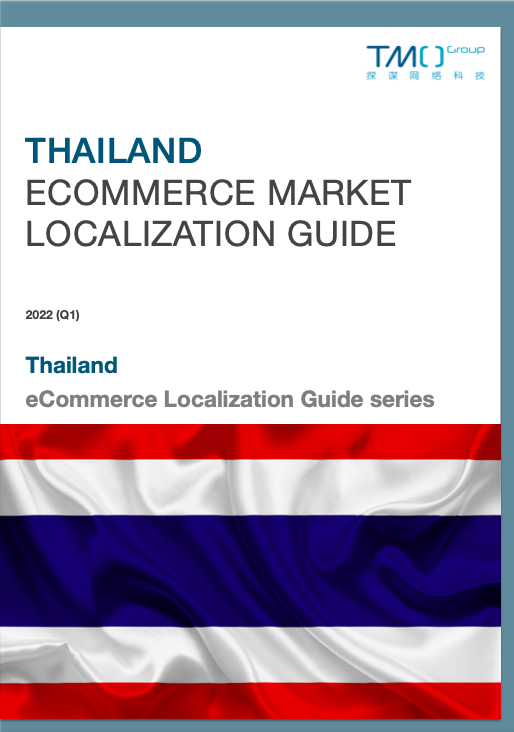Located at the continental heart of Southeast Asia, Thailand is one of the most exciting markets in an already exciting region. Sporting a more developed economy and infrastructure than most of its neighbors, conducting business is easier in Thailand for overseas companies.
In this article we introduce the country in general terms and then look at the realities of doing eCommerce there in 2022. If you want to know more, then check out our comprehensive Thailand eCommerce Market GuideThis in-depth primer aims to be your one-stop guide to the Thai eCommerce market, including how to take your business there and succeed.Thailand eCommerce Market Guide, or its free companion Thailand eCommerce Market Starter GuideStarter guide to the Thailand eCommerce market: statisics, market analysis, major trends, entry and marketing strategies overview.Starter Guide. Otherwise, keep reading for some Thai eCommerce insights!
Country Overview
Population
With a population of around 70.06 million, Thailand is the 20th most populous country in the world. The country is divided into 77 first-level administrative regions - 76 prefectures and the capital, Bangkok. More than 20 of these have populations over a million, while Bangkok itself has a population of 5.68 million.
The Thai population is 95% Buddhist, and scores highly on happiness indexes. There is a positivity among Thai consumers that extends into their buying behavior. In general, consumers trust businesses and corporations more than their neighbors, and are less bothered by privacy concerns than Western consumers. Additionally, Thai consumers are some of the most enthusiastic about offline retail in the region. This means that foreign companies can achieve success by pursuing offline channels to complement their eCommerce efforts.

Economy
For the last decade, Thailand has posted strong growth. On June 17, 2021, the IMD Business School authoritatively released the latest 2021 World Competitiveness Ranking report, and Thailand ranked 28th (China ranked 16th in the same period), up 1 place from last year. It is worth mentioning that although affected by the epidemic, according to the report of the National Bureau of Statistics of Thailand in 2020, the national unemployment rate has risen slightly to 1.02%, but the happiness index of Thai residents is still very high when compared with worldwide.
Foreign Direct Investment
Thailand has further encouraged foreign investment, vigorously promoting its Thailand 4.0 and EEC strategies, strengthening infrastructure development, and improving the legislative environment. According to the 2020 investment attraction report released by the Investment Promotion Commission of Thailand, the total amount of foreign direct investment attracted in the whole year was 213.2 billion baht (about US$7.1 billion).
After the covid-19 outbreak, it can be seen that the Thai government strongly supports foreign investment in the healthcare industry. Thailand has listed the healthcare sector as a priority investment sector in its “Thailand 4.0” policy. The Investment Committee actively promotes investments in the health sector to make Thailand a medical hub in Asia.
eCommerce in Thailand
Recent figures pegged the number of Internet users in Thailand at around 48.59 million, or 69.5% of the population. The number of eCommerce users, meanwhile, was estimated at around 36.6 million, or 52.3% of the population. With more than half the population already engaged in eCommerce, this makes Thailand a fairly developed market.
Data from Statista predicts that 10% of Thai retail will be made up of eCommerce sales by 2023. This is an especially impressive figure, given the passion Thai consumers have for offline retail. According to Statista, the eCommerce market size in Thailand is expected to reach a CAGR of 14.62% between 2021-2025.

The Thai government has stated that it plans to introduce specific eCommerce regulations in future. However, currently the policy direction remains uncertain. What that means is that for now companies do not need to establish a Thai legal entity in order to run a cross-border eCommerce business from an office in the country. However, foreign legal entities do still need to pay VAT (typically around 7%) and corporate income tax (typically around 15%) when doing business in Thailand.
Top eCommerce Platforms in Thailand
When it comes to market entry via eCommerce, here at TMO we recommend using the two major eCommerce platforms for B2C. Lazada and Shopee, giants in Southeast Asia, dominate the Thai eCommerce market. Their pan-SEA infrastructure and logistics networks put them a cut above local competition. Among the top 10 platforms, these two accounted for 83.58% of traffic between them.
But these two platforms are no mystery to anyone with an eye on Southeast Asia. What is worth watching is JD Central. It's a joint platform from Chinese eCommerce giant Jingdong (JD) and local mall and retail behemoth Central. Leveraging JD's online expertise, the platform has been able to achieve 4 hour deliveries in some areas.
This platform has had a promising start, and already rolled its joint expertise in online and offline to hybrid business ventures. These include a fully automated retail store in Bangkok, and ambitions to dominate Thailand's O2O sphere.

Cross-Border Market Entry
Cross-border is a particularly attractive option for overseas businesses wanting to sell to Thailand. This because you do not need a Thai legal entity to sell cross-border from a base in Thailand. The most common cross-border eCommerce model in the country is selling over Lazada and Shopee, which again do not require a Thai legal entity. These platforms both provide mature distribution services throughout Thailand. However, a base within Southeast Asia is required to pursue this path.
The major disadvantages with cross-border selling are high logistics costs, VAT at the border, and relatively slow delivery times. Additionally, cross-border selling makes after-sales service particularly complex. If returns and exchanges aren't easy and painless, then it can erode consumer trust and confidence.
Agents, Partners, and Distributors
Many foreign companies believe that finding a local distributor or agent is the best way to enter the Thai market. Local distributors are typically put in charge of customs clearance, dealing with established wholesalers and retailers, as well as direct or offline sales and after-sales service. Foreign companies can often benefit from such cooperation with distributors. This is due to their local insight and expertise, and greater familiarity with the Thai market.

However, the obvious disadvantage is losing complete control over your brand in that market, including how consumers perceive it. As distributors also usually control local pricing, foreign companies don't have the final say in brand positioning or price point. At the same time, splitting earnings can often lead to distributors pushing prices higher to get a better share, affecting the competitiveness of the product in the Thai market.
Before entering into any legal agreement with an agent, partner, or distributor, it's best to carefully check the company's reputation and past performance. Additionally, brands should check that these potential partners have the required permits, capabilities, facilities, and so on in order to reliably fulfill their side of any agreement. Failure to do so risks jeopardising brand image and reputation in Thailand.
Setting Up a Local Legal Entity
For other foreign companies, the best option is to establish a Thai legal entity. This enables them to directly handle sales, distribution networks, and services. As a result, companies can maintain total control over their brand in the country. Obviously, drawbacks include substantial financial commitments to entering the Thai market, possible screenings of joint venture partners, and having to tackle the task of competing in an unfamiliar market.
Want to learn more? Check out our recently launched Thailand eCommerce Market GuideThis in-depth primer aims to be your one-stop guide to the Thai eCommerce market, including how to take your business there and succeed.Thailand eCommerce Market Localization Guide for a comprehensive look at entering the Thai market via eCommerce.













